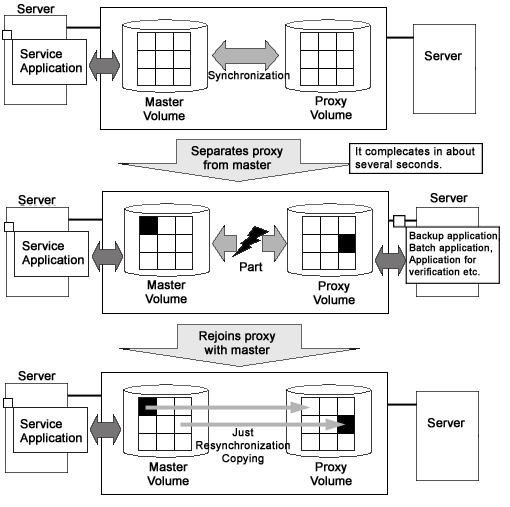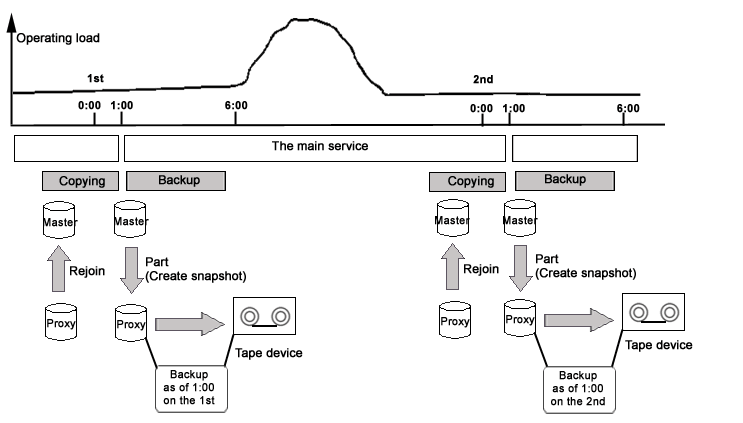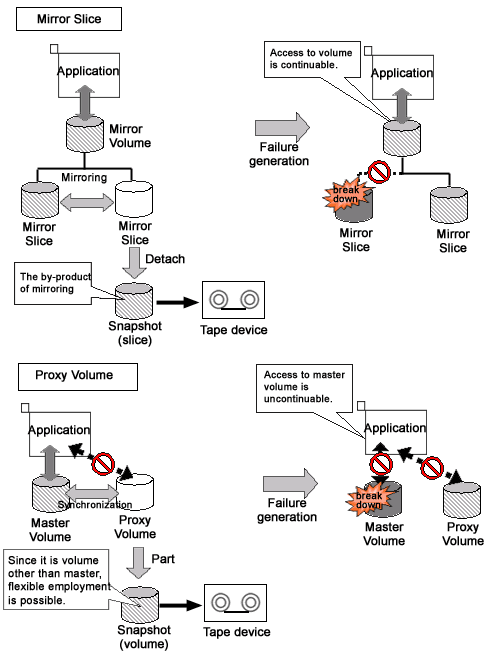A master volume snapshot can be created by synchronizing data of the master volume and the proxy volume in advance and then separating the synchronized proxy volume from the master volume at any moment.
Snapshot by synchronization minimizes the influence on the service application and is suitable for routine scheduled backup.
As long as the two volumes are synchronized, snapshot can be created easily by separating the proxy volume from the master volume. Creation of snapshot will only take a few seconds even if the amount of data is large.
When the proxy volume is rejoined with the master volume for the next snapshot creation, high-speed resynchronization is performed by copying only updated portions on the master and proxy during the separation using JRM (Just Resynchronization Mechanism) for proxies.
Figure 1.35 Snapshot by Synchronization

Therefore, both the snapshot creation and the resynchronization process before rejoining the proxy with master will have minimal influence on the service application.
For example, in a situation where loads imposed on disks are higher during the day than at night, if saving data to tape takes no more than 5 hours and resynchronization copying no more than an hour, the routine backup schedule is assumed as follows.
Figure 1.36 Example of a Daily Backup Schedule

Note
JRM for Proxies
JRM for proxies speeds up the just resynchronization process when joining a parted proxy again to the master and when the master data is restored from the proxy. GDS records the changes made on the master and the proxy on the memory while the proxy is parted. The just resynchronization conducted when rejoining or restoring copies only updates the updated portions to realize high-speed synchronization.
JRM for proxies is enabled when the pjrm attribute of a proxy volume is set to on and the proxy volume is parted. However, if any node that is included in the scope of the class is stopped while the proxy is parted, just resynchronization is not put in operation. In other words, the entire data, not only the updated portions, is copied.
Therefore, if you plan to shut down the system, joining the proxy to the master in advance is highly recommended.
Reference to these matters is not necessary when you are using the copy function of a disk unit.
Information
Three Types of JRM
There are three types of Just Resynchronization Mechanism (JRM): for volumes, for slices and for proxy. For details, see "A.2.21 Just Resynchronization Mechanism (JRM)."
Note
Ensuring Consistency of snapshot data
If you create a snapshot while an application is accessing the volume, the data consistency may not be ensured, as the volume data will be incomplete.
To ensure the consistency of your snapshot data, you must stop the application that is accessing the volume in advance. After creating the snapshot, start the application again.
For example, when using the volume as a file system such as GFS or ufs, unmount the volume with the umount(1M) command before creating a snapshot, and mount it with the mount(1M) command afterwards. This way, you can ensure the consistency of the snapshot data.
To create a snapshot while running the application, the file system or database system you are using to manage the data must be able to ensure data consistency.
For details, see "6.6 Online Backup and Instant Restore through Proxy Volume."
Note
The Difference between a Mirrored Slice and Synchronized Proxy Volume
Although data matches on mirrored slices or synchronized master volumes and proxy volumes, the purposes of use are different.
Mirrored slices are equals, and their purpose is to maintain data redundancy. So even if an abnormality is detected in one of the slices, the volume can be accessed as long as the other slice is normal.
However, even if the master volume and the proxy volume are synchronized, they are separate volumes and not equals. You may consider the master the primary volume, and the proxy the secondary volume. This means that even if the proxy volume is normal while all slices comprising the master volume are abnormal, you cannot continue accessing the master volume. The purpose of proxy volumes is to separate the master volume in order to perform a different task in parallel, and not to improve the data redundancy used by the service application.
In short, the snapshot by slice detachment is a by-product of mirroring, which is the primary objective, but the primary objective of the snapshot through use of proxy volumes is creating snapshots.
Therefore, GDS Snapshot provides more flexible disk configuration and supports various tasks.
Figure 1.37 Difference between a Mirrored Slice and Synchronized Proxy Volume
